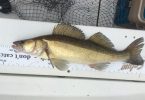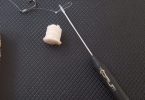River fishing can be one of the most mobile, exciting ways to spend a day angling. The prospect of chub, barbel, pike, perch and numerous other species make for some great fishing if you can find them. However; finding them can often be the problem, so what should you look for?
What is a fish holding ‘feature’? It can be anything which may give shelter, provide food, gives cover, supplies increased oxygen or any combination of all four. Water travels in straight lines and conforms to certain laws of physics; if you understand them and can ‘read’ the water, then you are halfway to a good day.
 There are two main flow types to consider in any river. The ‘laminar flow’ is in the middle part of the river, unaffected by bankside or riverbed friction and generally moves the fastest. At the sides of the river, ‘helical flow’ is the recirculating current, often seen to move things away from, and then back to the bankside. In a very fast river, this may even flow in the opposite direction to the main ‘laminar’ flow! Flow and pressure act in all dimensions and this needs to be remembered when viewing the water. Build up a 3D picture in our mind of what the water is doing.
There are two main flow types to consider in any river. The ‘laminar flow’ is in the middle part of the river, unaffected by bankside or riverbed friction and generally moves the fastest. At the sides of the river, ‘helical flow’ is the recirculating current, often seen to move things away from, and then back to the bankside. In a very fast river, this may even flow in the opposite direction to the main ‘laminar’ flow! Flow and pressure act in all dimensions and this needs to be remembered when viewing the water. Build up a 3D picture in our mind of what the water is doing.
It is far easier to assess a river when the water is low and clear. A pair of polarising glasses can be a huge help as they cut down glare from the sun and allow you to see deep into the river. Certain areas of the river often provide similar characteristics.
Any bend usually has a faster, deeper run on the outside, and a shallower shelf where the river deposits silt and debris carried from upstream onto the inside of the bend as the flow becomes slower. The outer bank may become undercut as a result of water pressure and erosion which will provide a safe refuge for many fish.
A speedy flow gives what could be called a ‘crease’. This is where the faster, inflowing water from upstream begins to lose its impetus as it enters a deeper pool. Food is often discharged at the edge of the faster flow as the river lacks the speed to support it up in the water. It is obvious to look at as the faster water pushes into the swim….
A steadily flowing river will move faster over a shallow bottom and then slow as the depth increases. At the ‘tail’ of a pool, run or glide, the bottom often slopes up to offer an area where food items will collect and be held. If you watch for any length of time, fish are often seen to rise at the lower end of a swim where this natural shelf occurs as food passes over it.
 A great place to seek big chub is under an overhanging tree, or below a ‘raft’ of flotsam which has become caught up in bank side vegetation. Within the roots or in the darkness is an ideal habitat for fish to hide from predators overhead, and to intercept food as it becomes trapped in the obstruction. It is also likely that tree living bugs and insects will fall into the water, just right for fish to grab and eat with minimum effort!
A great place to seek big chub is under an overhanging tree, or below a ‘raft’ of flotsam which has become caught up in bank side vegetation. Within the roots or in the darkness is an ideal habitat for fish to hide from predators overhead, and to intercept food as it becomes trapped in the obstruction. It is also likely that tree living bugs and insects will fall into the water, just right for fish to grab and eat with minimum effort!
Sunken trees which have been uprooted and washed downstream by previous flooding can give a fantastic chance of a few fish as they will hide with the root system which gives the chance of food and cover, but leave the angler with the problem of how to get into it without becoming snagged up; I’ll leave you to work that one out! Weedy swims offer the chance to drop a bait in between plumes of streamer weed…a deadly tactic for barbel, grayling and chub, especially over a gravel bottom. Don’t be afraid of fishing a weed strewn swim, baits often find a natural resting point as they drift down with the flow, this is precisely where the fish expect to find it.
Large rocks or boulders create an eddy which is an area of water that appears to swirl around behind the obstacle. Once food enters this area, it is held for a considerable time, and the upstream flow gives shelter from excessive flow which, in turn, means that the fish need to expend less energy maintaining their position. Breaks in the integrity of the river bank will additionally yield a recirculating current as water rushes in to fill the space. A sub surface rock will cause a ‘standing wave’ which never seems to move from a certain spot in the river. Imagine that the water flows up and over the boulder then generates an eddy as it rushes to fill the space behind the barrier; again, this is a region of low pressure that will collect anything which is passing downstream and make it easier for the fish to maintain its location.
Temperature affects the water in various ways. Deep water is often colder, and shallower swims are the first to warm when the sun comes up. Fishing improves as the water temperature begins to rise after a heavy influx of rain, and this is known as the river ‘fining down’ as the levels start to drop following a flood. Large amounts of cold rain water also affect the amount of activity on the bankside, resulting in a drop in the amount of food entering the water.
 Man-made impediments to the flow of a river take many different forms. It may be as simple as a shopping trolley or pedal cycle which establish something which must be avoided, or as complex as a weir that is something to be looked on a definite fish holding region. Bridges, weir pools, locks and boats all give an excellent chance of fish. Strong flows and eddies are formed by the concrete blocks and shelves, all of which attract fish. The tail of a weir pool is especially likely to give good bags of fish as they compete for food tumbling around in the churning water.
Man-made impediments to the flow of a river take many different forms. It may be as simple as a shopping trolley or pedal cycle which establish something which must be avoided, or as complex as a weir that is something to be looked on a definite fish holding region. Bridges, weir pools, locks and boats all give an excellent chance of fish. Strong flows and eddies are formed by the concrete blocks and shelves, all of which attract fish. The tail of a weir pool is especially likely to give good bags of fish as they compete for food tumbling around in the churning water.
Deep, dark holes undercut in the bank side are a favourite haunt of big perch. Hunting by sight, these superb fish will burst out from cover to snatch an unwary baitfish as it struggles past; always worth dropping a bait into, but be prepared to hold on if you hook one as it will know the swim far better than you could hope to and will almost certainly find something to snag the anglers hook in!
I mentioned earlier that it was a good idea to view the river when the water is low. When it rains, the river may change completely in just a few hours, and, if you have seen the river previously, then you can remember where the fish rich areas may be. A large amount of rain will also result in debris being swept down off the bankside, banks may collapse as they are worn away, and the river may even flood into the surrounding fields. The outcome may be a totally different river!
 A couple of other things that may be worth thinking about. As the refractive index of water is different to that of air, fish may be able to view your approach towards the bank before you have a hope of being close enough to see them (think of a spoon entering a glass of water and think how the spoon appears ‘split’ as the light ‘bends’ where air and water meet). This makes it vitally important to keep low against the skyline so that you cannot be seen.
A couple of other things that may be worth thinking about. As the refractive index of water is different to that of air, fish may be able to view your approach towards the bank before you have a hope of being close enough to see them (think of a spoon entering a glass of water and think how the spoon appears ‘split’ as the light ‘bends’ where air and water meet). This makes it vitally important to keep low against the skyline so that you cannot be seen.
Fishing in safety is also imperative especially for younger, inexperienced anglers. Many rivers are crossed by high voltage cables, so carrying made up rods may not be a good idea, and care needs to be exercised when casting. The nature of moving water means that some hazards are impossible to see or identify until its too late. The human body loses heat twenty seven times faster in water than in air, so in winter, falling in results in hypothermia and cramps that stop any chance of rescue. High banks are difficult to climb, even more so if wet and undercut. Waders, wellies and heavy clothing can present problems if they become sodden and inhibit swimming. Barb wire and large animals such as cattle can sometimes be dangerous if the angler is unaware of his surroundings.
Each river is different, and each will change with the seasons; the fun in river fishing is learning about your stretch and applying that knowledge to outwit the quarry. Try it, you will enjoy it.
Clint Walker

Result of reading the water sucessfully

Sometimes, though, you may just want to stop right there and take it all in…




















